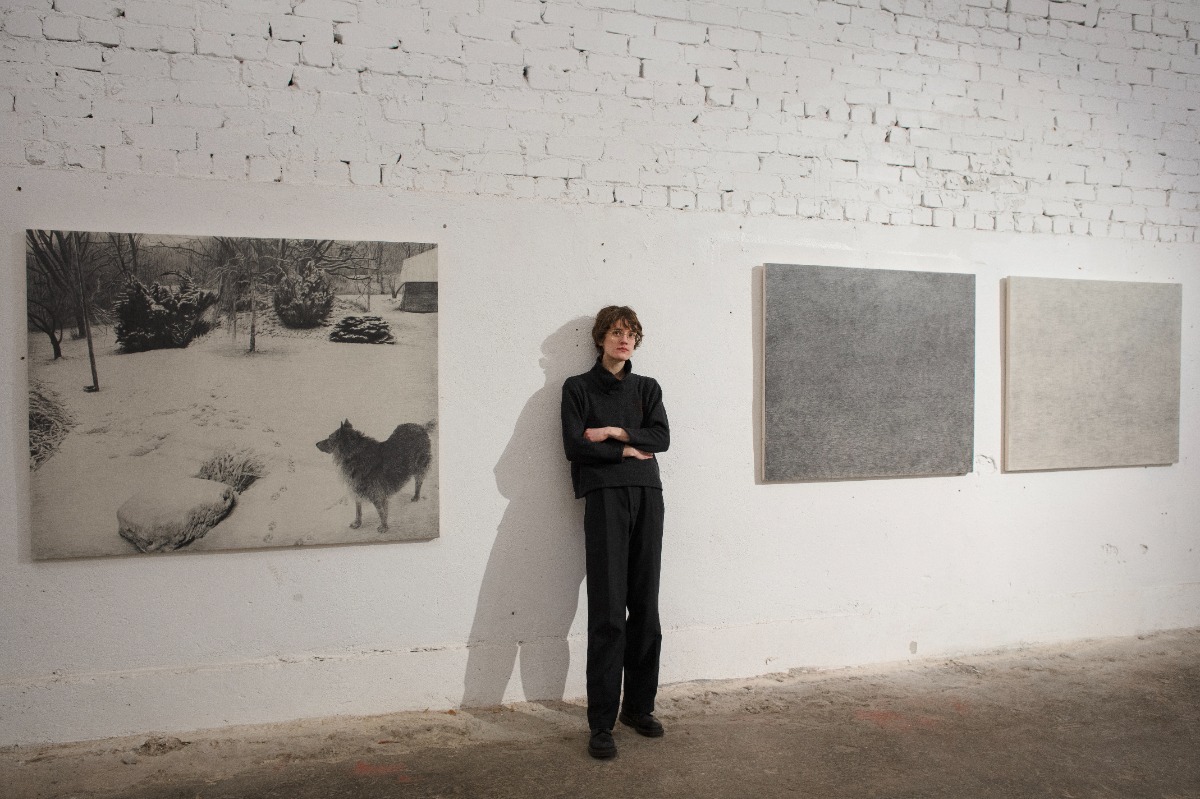
The landscape outside the window is not to be taken for granted
A conversation with Luīze Rukšāne / shortlisted for the Purvītis Prize 2025
Luīze Rukšāne is one of the shortlisted candidates for the 2025 PURVĪTIS PRIZE. Her solo exhibition ‘Folding Lines’ that earned her the nomination was on view in the early 2024 at TUR_telpa in Riga. Viewers will have another opportunity to form their opinion about it at the exhibition of works by the shortlisted 2025 PURVĪTIS PRIZE candidates at the Latvian National Museum of Art, open from 12 April through 8 June 2025.
The artist Luīze Rukšāne possesses a tricky-to-describe sensitivity, a quality embodied in its own way by her seemingly fragile yet markedly purposeful physical figure. Not coincidentally, for a long time her passion was horses. It is impossible to pretend when communicating with them; any kind of collaboration with these majestic animals, companions and teachers of man throughout centuries, is possible only as symbiosis. To an extent, it seems to be true of Luīze’s relationship with her pencil as well: almost an organic part of her personality, it becomes a tool in her hands, allowing the rest of us notice moments we often tend to underestimate and perceive as something obvious – like the landscape outside the window, captured on her tablet by Luīze’s grandmother throughout the years. We all have a landscape like that; perhaps we would not even notice it if it were not for Luīze, who encourages us to take a look at it from a completely different vantage point by painstakingly transferring it to her drawings. She invites us to acknowledge things and persons who have formed and continue to form us, appreciate them, feel grateful to them and also take care of them – or, conversely, untangle them, work through them and set them free. Because nothing of what surrounds us should be taken for granted.
Folding Lines. 2024. Exhibition view. Photo: Kristīne Madjare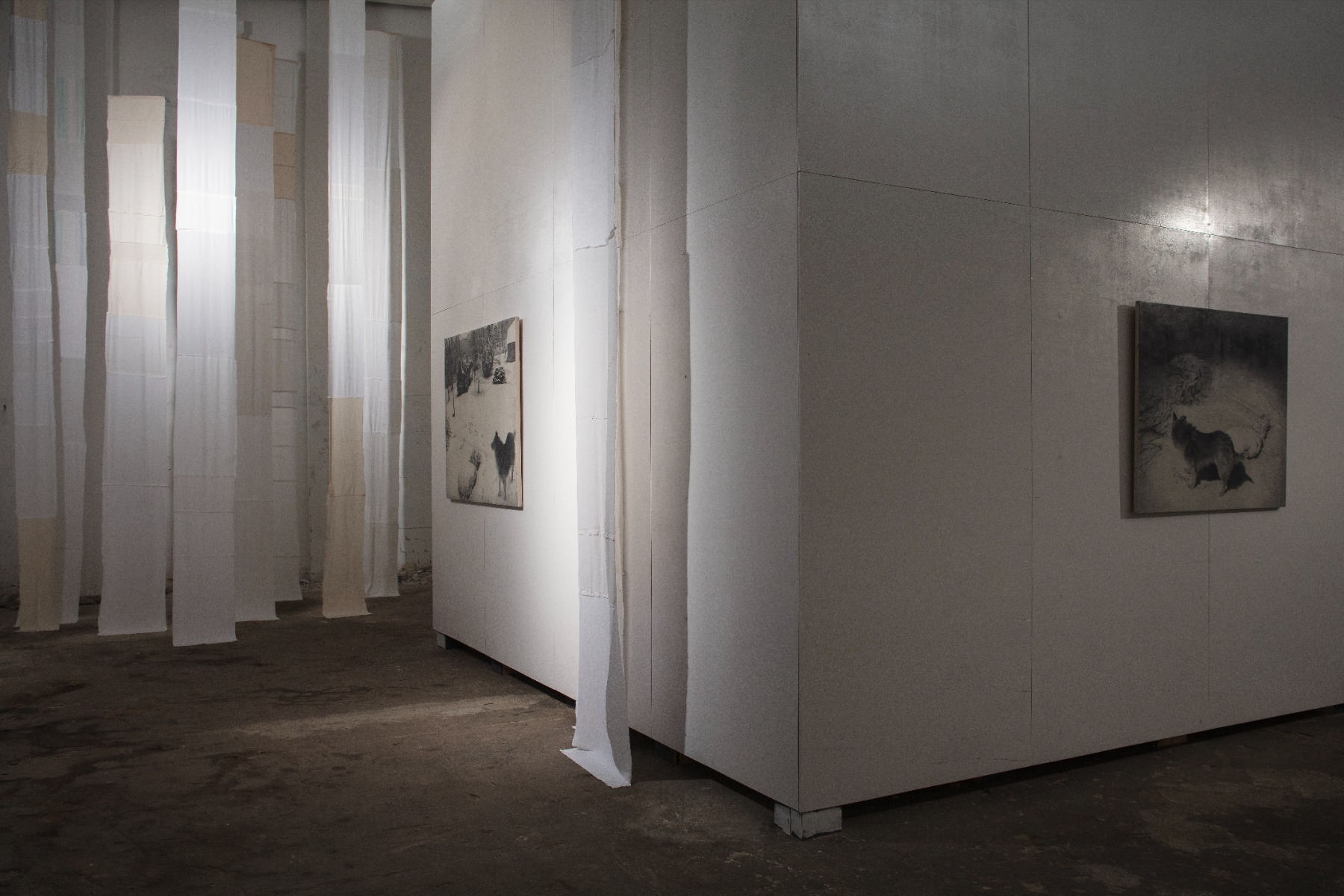
Having followed your activities as an artist, both in exhibitions and other projects, I have come to feel that roots and their paths, zigzags and affinity to a specific place or territory are very important to you – be it your familial roots, undeniably present in your solo exhibition ‘Folding Lines’ that ran at TUR_telpa space for art and has brought you a Purvītis Prize nomination, or the objects, including actual tree roots, found on the seashore and captured in drawings shown at your ‘Exhibition About Falling in Love’ that was on view at the Look! Gallery. Perhaps you are also exploring some issues that are quite personally relevant to you through your art. Have you ever given some thought to the roots of your own works?
I feel that the subjects of my works are in a way quite intuitive. Now, when I have already amassed a certain archive, I try to look back and figure out where it all has come from and why. I am aware that a lot of motifs – both in this exhibition and others – can be traced back to Pulkas, the house where my grandparents lived. I am attempting now to find the common denominator and see if it is actually going anywhere. In a way, I am trying to put this experience in a wider context.
Have you already realised anything during the process?
Whenever I am asked for a short bio, I always say that my works are all about memories, about the ways in which personal memories are incorporated into the bigger picture and context of communal memories. Other people may find it obvious, but it was only recently that it dawned on me that these were not just memories of some sort: these were also the links between memories and nature. In a way, it is also the story of nature forming our memories and becoming a part of them. That, for instance, you can learn something by revisiting the same forest, the same landscape again and again in your art.
Folding Lines. 13 textile pieces in different sizes. Photo: Luīze Rukšāne
It would never be the same forest or the same landscape. Something must have changed for sure; there must have been some development.
Hence the saying that you cannot step in the same river twice.
Admittedly, you do occasionally try to step in it twice, including through transferring a photograph to a drawing. Then again, the same forest is instantly transformed into something else altogether once it assumes the materiality of a drawing. Have you ever wondered why you are not satisfied with what you already have, namely, the photograph? Why do you feel the need to transfer it, store it away in a different materiality?
I have thought about it a lot. In the context of this exhibition, for example, it is also a kind of appropriation. The photographs are not mine; they are my grandmother’s. And in a way, I appropriate them and make them mine through drawing. It is also a bit like a way of making a larger ‘printout’. At the same time, it is not just a printer: by investing my time, I seem to be paying them more attention. It is a way of making others spend more time viewing them as well. And it is most definitely a way of making myself spend more time viewing them. I look at it and I examine every tiny square centimetre in the picture; I impart significance to it. The photographs I used in this exhibition were taken by my grandmother on a tablet. They are seemingly random recordings of the weather at the time. And I feel like I am investing it with more weight through the process of drawing, urging everyone to spend more time viewing it, perhaps notice some details.
The watcher of the signs of the time 2. 2023. Graphite and charcoal on canvas, 100 x 120 cm / Latvian National Museum of Art collection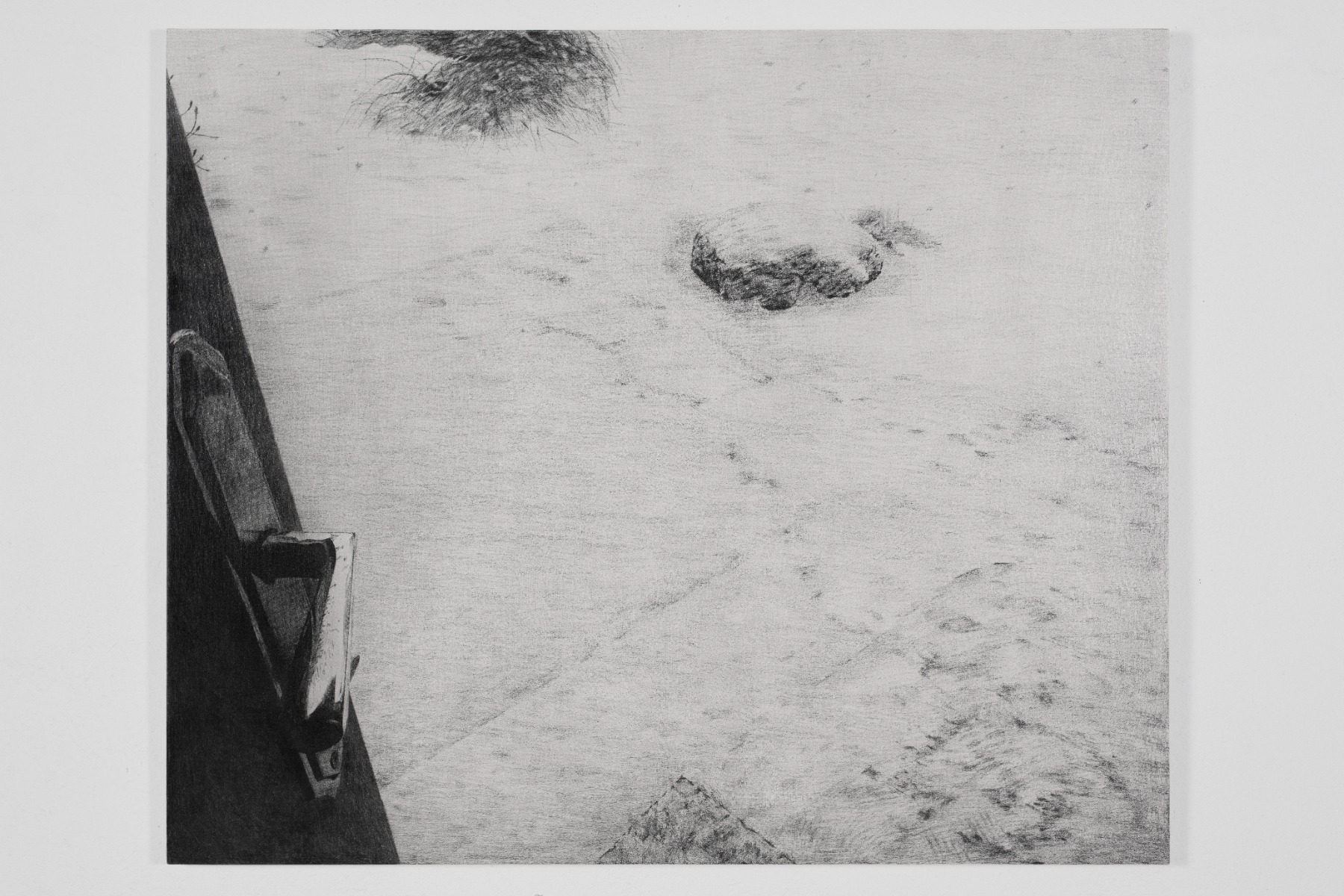
Have you ever happened to notice a detail suddenly yourself in the photos while drawing from them?
Speaking of Grandmother’s photos, it is the fact that they feature approximately the same locations, capturing them at different hours, in different weather and from different angles. I definitely notice these relative repetitions in a more pronounced manner – the way they repeat in time through the years. When I am at her place now, I catch myself looking slightly differently at snow-covered trees, for instance, because I know how to draw them. I notice details, patterns that seem to repeat themselves while changing all the time.
Does the hand also possess the faculty of memory? Have you ever sensed it while you are drawing?
I think it does. I am currently working on a project in collaboration with the Neatlaidība (Persistence) Society, a book where I continue a subject that I first tackled a few years ago. I had this series featuring Grandmother’s snowmen, and now there are new snowmen set in a very similar place. It is interesting to note how my manner of depicting things has changed – the ways in which it has changed or seemingly remained the same. I once showed a series of works at Riga Art Space where I repeated the same image 24 times. The question arises: does the hand remember it? Does the image become superior, better drawn, or is it the opposite case and it becomes increasingly sloppy? It was an interesting way for me to explore the actual process of drawing.
Folding Lines. 2024. Exhibition view Photo: Kristīne Madjare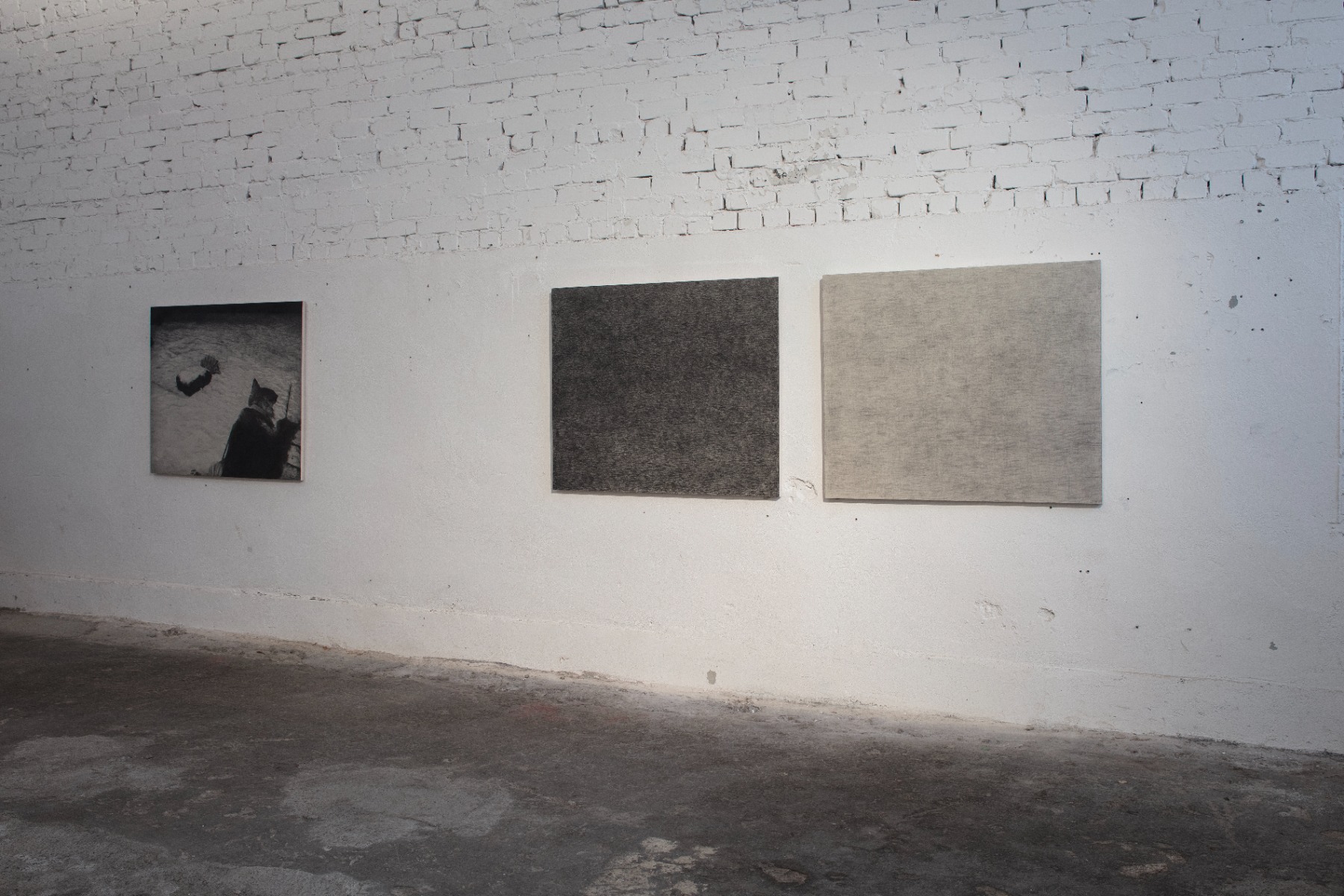
What is it that attracts you to drawing most?
I just like to do it, particularly using a photograph as a point of departure. It seems to include a clearly defined objective to strive for: I already know how the picture should look like because I am trying to imitate a photo. I don’t have to make a lot of decisions during the process. I can switch off to an extent. To exist in this simple automatic mode of moving forward. I like it very much.
Meanwhile, you are constantly striving to push the boundaries of what we understand by drawing, including transferring drawing to canvas. Why is it important for you?
Preparing the exhibition at TUR_telpa was the first time I started drawing on canvas. It was for totally practical reasons, actually: I knew that the show was to open in mid-January, in winter, and the room does not have any heating. It was 15°C in there on the opening day. Clearly, it is almost impossible to show works on paper successfully when it is so cold in the room. Moreover, the room is big, and it was quite obvious that I had to go for a larger format. And so I started experimenting on canvas. I did not study at the Faculty of Painting, but I know that drawing on canvas is part of the learning process for painters at the Latvian Academy of Arts. I think it is a very valuable and interesting practice. It is only now, studying in Hamburg, that I realised it was not the common approach everywhere; drawing on canvas is quite unusual at other art schools.
I think there is also a very practical side to it: canvas is much more durable than paper. Besides, it allows me to make larger works. It may seem that the facture of the canvas does not lend itself to delving into such elaborate details. Perhaps canvas could also be rendered perfectly smooth by applying several coats of primer and used for drawing the tiniest details. But I love the fact that I can make more liberal strokes on it.
Signs. 2024. Graphite on plywood and canvas, 20 x 14 cm. Photo: Kristīne Madjare
In a way, the main difference between paper and canvas is this sense of freedom.
Yes, as they would say at Janis Rozentāls Art School, švunka, the drive. There is a different energy to the stroke, although I am using the same pencil as for my drawings on paper.
You are obviously also interested in the materiality of fabric because fabric frequently leaves the confines of a frame. In the ‘Folding Lines’ exhibition you had used tablecloths and bedsheets that, handed down from generation to generation, had once belonged to a woman who is now no longer in this world. It seemed like you gave them – these things that may have suddenly lost their purpose and perhaps even become a nuisance in a way – a continuation and a new meaning.
There was also a work in the exhibition featuring fabric glued on plywood. I have always been interested in materiality. In other exhibitions as well, I always want to bring something else besides paper into the room. Usually it is wood, which I have always found a very meaningful material. Some wooden chairs or an installation, for example. In the show at TUR_telpa it was this cotton fabric that constituted quite a significant part of the exhibition conceptually – this heritage left behind by a woman and then deemed redundant and unwanted. I took it, started playing with it, making, as I call it, a ‘birch grove’. I thought it was interesting to show that the canvas on which I had been drawing also somehow ventured outside the drawing. It appears in the surroundings of the picture and the viewer can not only look at the drawing but also see the actual canvas.
Photo: Kristīne Madjare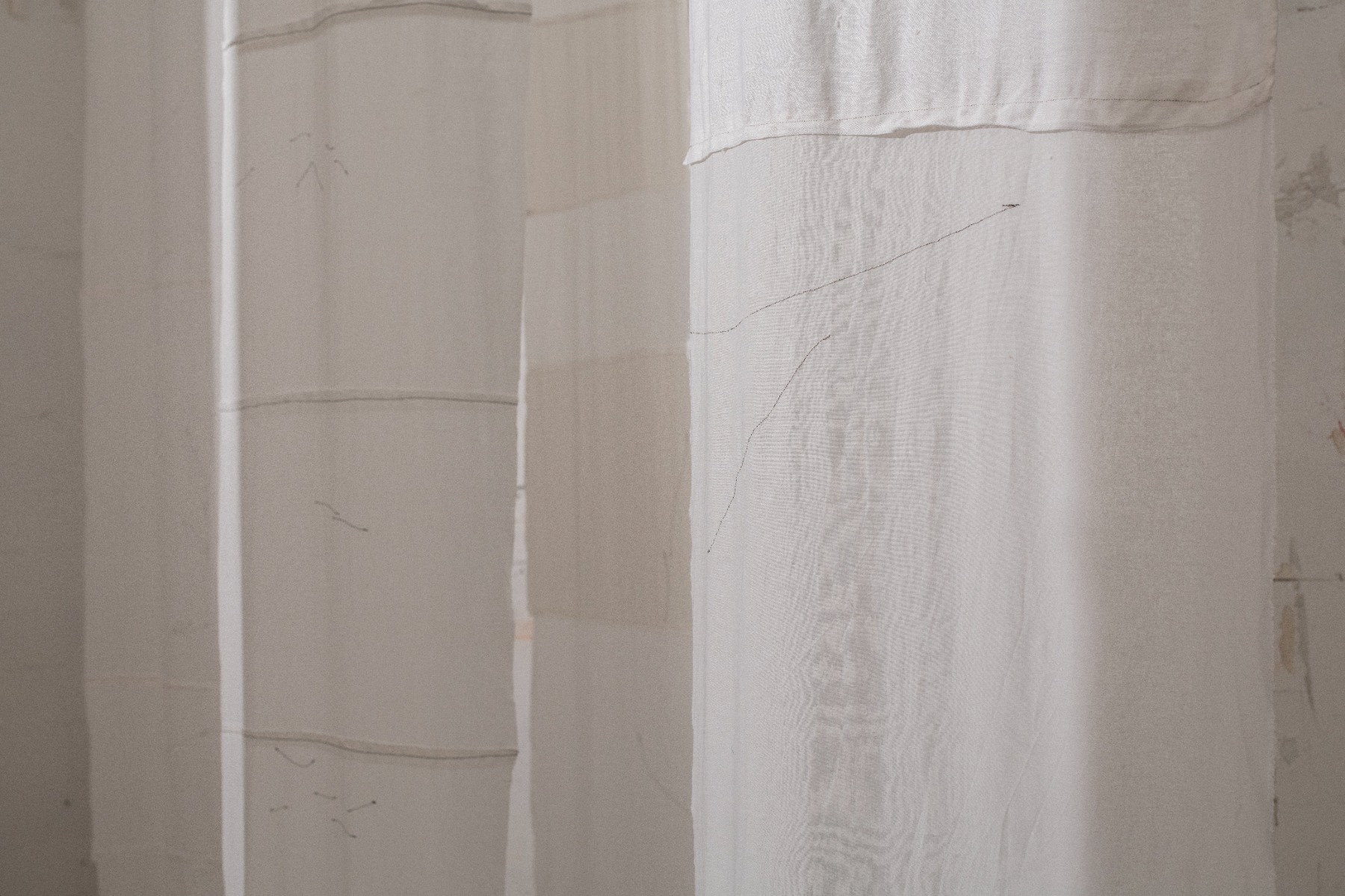
You mentioned the presence of wood; why is it important to you?
I feel that this one is also a purely intuitive process for the time being. I am currently increasingly searching for various materialities, various surfaces on which I can draw. For instance, now, while I am studying, I am looking for various wooden objects that previously belonged to somebody and were serving some sort of purpose but have now lost any practical use. I try to think of ways to make them friendly with the drawing or become part of it. I believe that materiality has a special effect on us on a sensory level. Wood embodies warmth and, in a sense, also safety.
Photo: Kristīne Madjare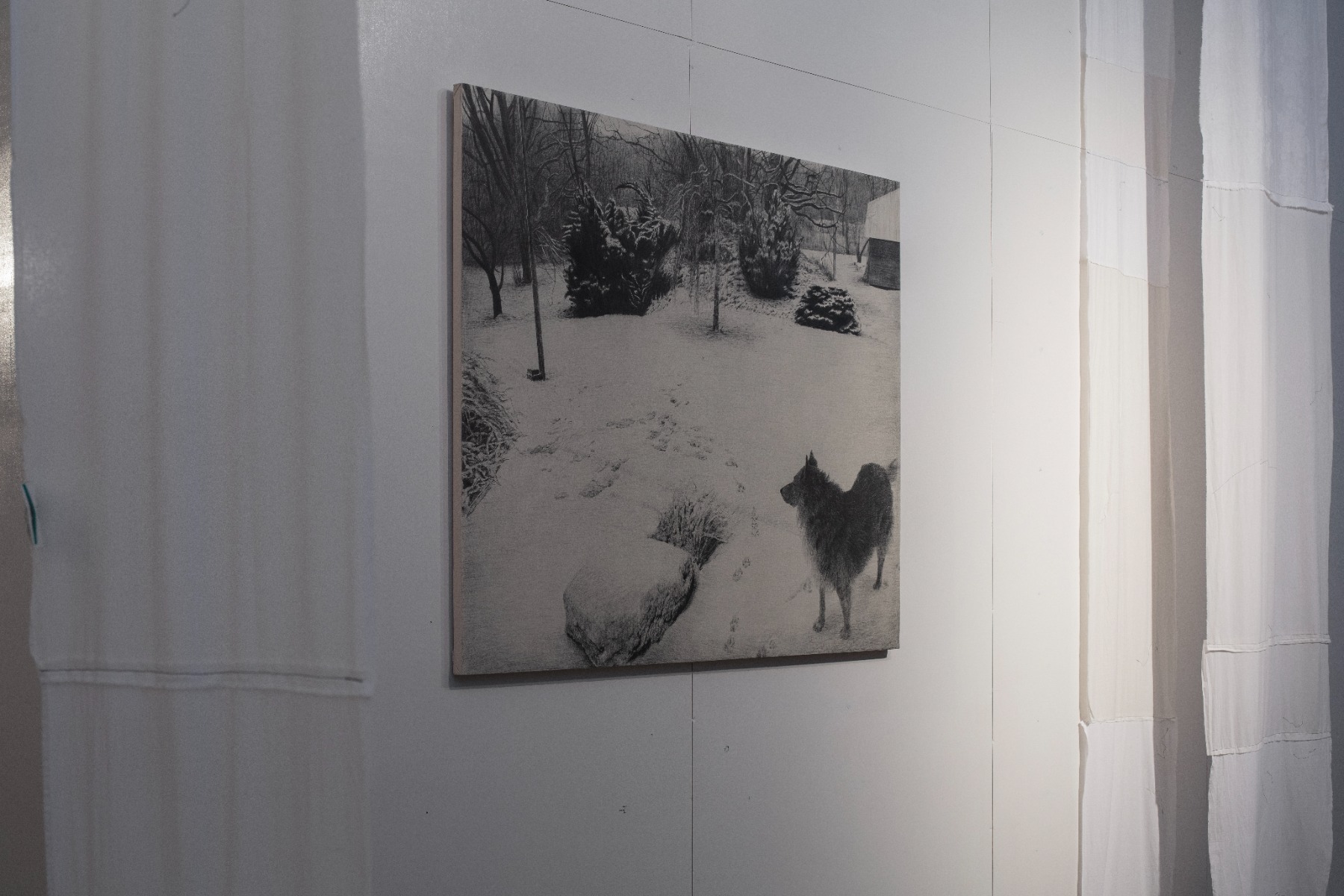
What about canvas?
Perhaps it is different for everybody, but fabric could also be closely linked with a sense of home. The cultural context matters a great deal here: while wood is the material that creates this sense of home and warmth for us here in Latvia, it could as well be marble for people in Italy. I personally perceive stone as an information carrier and a very solid thing; however, it is cold, and I definitely would not want to live on stone flooring.
How do you see the place drawing currently holds on the general art scene? Perhaps it is changing and drawing has once again become more relevant today to an extent?
I think it is a question that should perhaps be forwarded to art researchers because I am more likely to look at drawings and notice them from a practical angle. And I am glad that so many artists now work in drawing in Latvia as well. Compared with oil on canvas, drawing has always been like a second-grade artwork. It is simply that oil on canvas is a combination physically more resistant against the impact of time. You need to take much more care of a drawing. But technologies evolve, and quite a lot of things change. Perhaps it will also apply to the way the medium of drawing is positioned.
In a way, drawing is perhaps a very therapeutic process.
I believe that art in general is a therapeutic process. People sometimes are quite contemptuous about it, saying that what artists are actually doing is merely practising self-therapy, but then any creative process is really quite therapeutic.
The watcher of the signs of the time. 2023.Graphite and charcoal on canvas, 100 x 120 cm. / Latvian National Museum of Art collection
You are also practising it, in a way – by intuitively searching for a sense of belonging, untangling your relationship with your grandmother.
Yes, on the one hand, it is a very personal matter; on the other, I am far from the only representative of my generation who has some kind of relationship with someone from a different generation. I find it very interesting. Perhaps it is not always easy, perfect and lovely but it is definitely a learning opportunity. And I think that it is currently very relevant for many people.
Did your grandmother see the exhibition?
Yes! In a way, it is actually our joint show, because these are her photos after all. She gave me permission to use them. And I feel that the exhibition reveals her creative qualities as well as mine. She has always been a very creative person, which is demonstrated, among other things, by her approach to designing her garden. If other people’s grandmothers had a row of potatoes, a row of strawberries and row of lettuce in their gardens, I remember that mine had always planted everything in circles and spirals. Her vegetable patches and flowerbeds were instantly recognisable. And the photos she has taken on her tablet embody her vision most definitely. I feel that the exhibition is, in a way, a tribute to her creative expression.
Cold hands but a warm heart 3. 2023. Graphite and charcoal on canvas, 100 x 150 cm
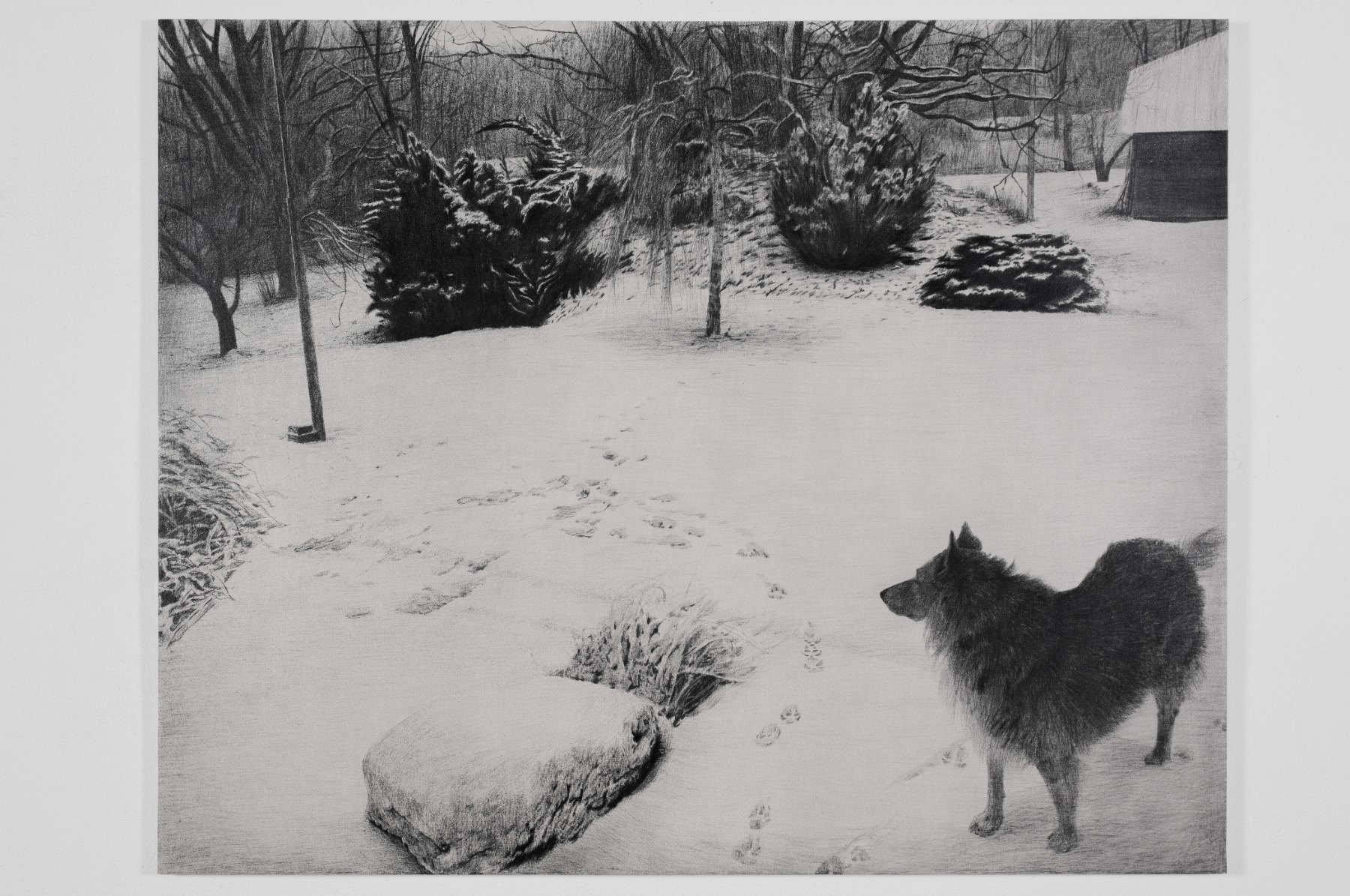
Have you figured out why your grandmother takes pictures, captures these views outside her windows?
She lives in this house, she is frequently all by herself, and she sees the beautiful things in nature; she wants to record it and share it. I believe it is some kind of wish to capture and record the things that she sees.
Has the exhibition inspired you to pay more attention to the things you see outside the window in all the different places you find yourself in?
Perhaps I have inherited this from Grandmother, but I have felt this urge since I was a child. Still, it is very interesting to see the very same impulse expressed through her eyes and camera and compare it with mine. Considering my education in art, my pictures are sometimes perhaps too deliberated. Whereas in her case, it is not so much about the look of the picture as the fleeting moment. It is vitally important to her to capture it, and sometimes the result of this seeming randomness is a much more interesting composition. A slanting horizon, not a level one.
Considering the uncertainty and the now practically perpetual turbulence of our life, we have all of us become much more sensitive. Perhaps more open to art, to an extent. In your opinion, what is the role of art today?
I think there are a great number of artists and, consequently, a lot of various types of art that serves different purposes. There is art that can work as a calming factor and art that can be the exact opposite, a revolutionary catalyst. The goals can be very different but there is one particularly relevant in an institutional context, and it has to do with social interaction and fostering an inclusive society. To an extent, it is in the latter context that I see myself: I would like my art to be intellectual yet also accessible on the level of emotional intelligence. I would like it to be reasonably comprehensible to people, and I believe that working with photographs facilitates that: the images are all very recognisable, which invites a person to view them a little bit longer and take a deeper look.
Perhaps on an emotional level, then, this exhibition, which was inspired by your grandmother’s photographs, is about a sense of security. An illusory peace haven.
It would be nice, of course, if that were true. It would be a good thing to achieve.
Whatever happens, there will still be this landscape outside the window…
I hope there will be. Because, you know, I fear it is no longer such a safe bet today. In any case, I am starting to question it. I believe it is exactly the precariousness of the current geopolitical situation, including our region, that makes us appreciate more the things we see outside the window every day. And it makes us aware that we must protect this landscape. It is not a given for eternity, and it is not to be taken for granted. Under these circumstances, the landscapes we may perhaps feel fed up with and sometimes find sickly-sweet acquire a completely new meaning and value.
Title image: Luīze Rukšāne. Photo: Kristīne Madjare